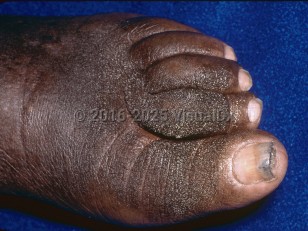Globally, the disease affects about 4 million people. Podoconiosis has been reported in 32 countries, including in central Africa, Central and South America, and northern India, of which 10 countries have a high burden of the disease. Ethiopia is the most affected country, with an estimated 1.5 million cases, while in Cameroon and Rwanda, 40 000 and 7000 cases of podoconiosis, respectively, are estimated.
The disease is more common among barefoot farmers who live in highland areas and affects women more commonly than men (male-to-female ratio of 1:1.4). The mean age of onset of podoconiosis is 25 years (age range 5-93 years). Over half of patients report stigma and impaired mobility in daily activity, resulting in considerable morbidity and limitation of economic performance.
The etiology and pathogenesis of podoconiosis are not clearly known. On the basis of its geographic distribution, affected communities, and clinical presentation, it likely results from long-term exposure to red clay soil derived from volcanic rock. The most accepted hypothesis is that disease is caused by mineral particle from the soil penetrating bare skin and inducing inflammation of cutaneous lymphatic vessels in individuals with a genetic susceptibility. More specifically, it is thought that the particles in the soil enter via bare skin and are engulfed by macrophages in the lower limb lymphatics plexus, inducing an inflammatory response in the vessel lumina. This is followed by fibrosis and obstruction of the vessel lumen, leading to edema of the lower leg, which progresses to elephantiasis.
There is very limited study on the molecular pathogenesis of podoconiosis, but one study suggested the involvement of transforming growth factor 3-1 (TGF 3-1) may play a role. Other suggested predisposing factors are familial heritability (siblings have a 5 times higher chance of contracting the disease than the general population), genetic susceptibility (HLA-DQA1, HLA-DQB1, HLA-DRB1), and micronutrient deficiencies.
Podoconiosis is a localized disease, primarily starting at the feet and progressively involving the legs; in most cases, it remains below the knee.
Clinically, the disease severity is classified into 5 stages.
Stage 1:
- Swelling reversible overnight; it is not present when the patient first wakes in the morning. It is usually confined beneath the ankle.
- Below-the-knee swelling that is not completely reversible overnight; if present, nodules / papules are below the ankle only. Persistent swelling does not reach above the knee.
- Nodules / papules may take the form of dermal nodules, ridges, and bands. Tourniquet-like effects (bandlike pressure that can further compromise the backflow of lymphatic fluid, such as from external pressure from shoe straps) may be observed at this stage or any subsequent stage, especially if this overlies a joint.
- Mossy changes may be apparent, but their presence depends on a range of factors including the use of plastic footwear. Interdigital maceration and hyperpigmentation are often present at this stage, and nail dystrophy is almost always present.
- Below-the-knee swelling that is not completely reversible overnight; nodules / papules present above the ankle.
- Persistent swelling does not reach above the knee.
- Dermal nodules, ridges, and bands are seen or felt above the ankle. Tourniquet-like effects are frequently observed at this stage.
- Any of the other changes mentioned for stage 2 may also be present.
- Joint mobility is not affected.
- Above-the-knee swelling that is not completely reversible overnight; nodules / papules present at any location.
- Persistent swelling is present above the knee.
- Any of the other changes mentioned for stage 2 may also be present. In addition, signs of lymphectasia may be apparent, particularly on the thigh.
- Joint fixation; swelling at any place on the foot or leg.
- The ankle or interphalangeal joints become fixed and difficult to flex or dorsiflex. This may be accompanied by adhesion and fusion of the toe web spaces, making the toes appear short or indistinct. Sensation is preserved. X-rays show tuft resorption and loss of bone density.



